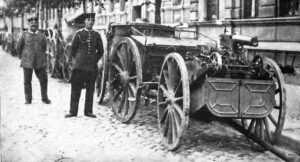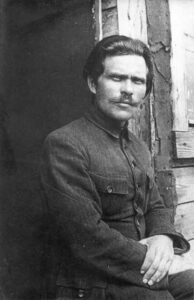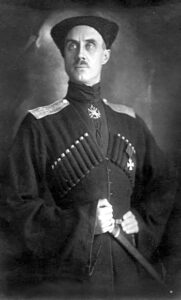
Tachanka and the Black Army
One of the most famous Russian-language songs to come out of the Russian Civil War, and also subsequently sung in World War 2 was called “Tachanka.” To this day, school children from across the former Soviet Union, the entire former Soviet Bloc, and even former Yugoslavia are taught to sing the song, which is about a horse-carriage mounted heavy machine gun, invented by the Red Army to defeat the superior White Army Cavalry. It’s creation was credited to Vasily Chapayev, an ethnic Russian Red Bolshevik Commander during the Russian Civil War. Yugoslav children learned the as part of the military and civic education which went with being part of Tito’s Pioneers (6 – 12 years old) and Tito’s Youth (12 – 17 years old).
Hey Tachanka gun from Rostov,
You’re our joy and you’re our pride!
Red Cavalry gun-carts blast off,
Four wheels whirling as they ride.
We crossed the Don, after the Volga
Through the Golden Steppe so Free!
Tanned an dusty our young machine gunner
Blasted through our enemy
However, the tachanka myth is just a myth. The gun carriage existed, and it was used against the White Russian Cavalry, but it was invented by the Commander of the Black Army, Nestor Makhno. Makhno was a Ukrainian Anarchist opposed to the Soviet occupation of Ukraine, and Makhno’s Black Army frequently used tachankas in battles against the Red Army. At one point or another, the Anarchist Black Army fought against every other side in the Ukrainian War of Independence, which was fought in 1917 to 1921, contemporaneously with the Russian Civil War. The Ukrainian War of Independence sucked in Ukrainian Nationalists, Black Army Anarchists, Imperial German Troops, Austro-Hungarian Troops, Polish Forces, the Russian White Army, French soldiers, Romanian soldiers, and was eventually won by the Soviet Red Army in 1922, absorbing Ukraine into the fledgling Soviet Regime.

Makhno himself was a larger than life character. His Black Army, officially the Revolutionary Insurrectionary Army of Ukraine, was formed in southeastern Ukraine in July 1918, with the Russian Civil War in full swing, with various armed groups roaming free across Ukraine and declaring independent governments. The Black Army varied in size, growing and shrinking in tune with its battlefield losses and successes – at its height it was 150, 00 troops, but at its smallest with was 15,000 troops. It started with equipment captured by retreating German and Austro-Hungarian troops, but soon diversified, using captured equipment from various opponents and creating the tachanka as well. As well as incorporating equipment from vanquished foes, the Black Army also built its strength from defecting troops from both White and Red forces. The Black Army strength in equipment acquisition and non-standard recruiting was balanced by its inability to produce war material and engage in traditional recruiting and conscription.

One of the greatest victories of the Black Army, was the capture of Yekaterinoslav from the another revolutionary group in Ukraine, the Ukrainian People’s Republic (UPR) on 27 December 1918. The UPR maintained a small air force consisting of 7 aircraft. Makhno was prevented from seizing the aircraft for the Black Army by an agreement with the Red Army, which was allied to him at the time. The Red Army offered to use the aircraft in support of joint offensives with the Black Army against mutual enemies. But this would make an impression on Makhno, pushing him to try and seize aircraft for exclusive use by the Black Army. On 15 March 1919, Makhno succeeded, with the defeat of a White Army unit which yielded 5 captured Farman HF.30 aircraft. Makhno wired for a pilot and a mechanic, and the Black Army was able to bring one of the aircraft into operation, in time to use it to assist in the capture of Mariupol on 28 – 29 March 1919. Later, Makhno would use the plane for personal transportation.
The alliance between the Red Army and Black Army against the White Army would continue through October 1920, when the White Army, led by General Piotyr Wrangel was finally pushed into retreat from Crimean into Constantinople, and finally into exile in Serbia.

In November 1920, the Makhno’s Black Army would be thanked for its assistance in defeating Wrangel with an all out attack by the Red Army, including by the aircraft seized by the Black Army at Yekaterinoslav. Makhno’s Headquarters Staff were arrested at a Red Army a planning conference and summarily executed. The Soviet Chekists, the secret police, went on a coordinated campaign to eliminate all Black Army troops, their anarchist allies, supporters, and sympathizers.
Makhno himself escaped to exile in Paris. He became a carpenter to earn money. He continued pushing the political philosophy of anarchy and communism until his death from tuberculosis on 25 July 1934 at age 45. His wife and daughter suffered a far worse fate. They were deported to Nazi Germany during World War 2, and after liberation were arrested by the Soviet secret police, put on trial in Kiev, and sentenced to 8 years hard labor.
The anarcho-communist movement was dead in Russia, but the Soviet authorities understood the attraction of the non-authoritarian form of government advocated by Makhno and his Black Army, so they had to ensure it no trace of it remained free.
- December 9, 2020
- History
